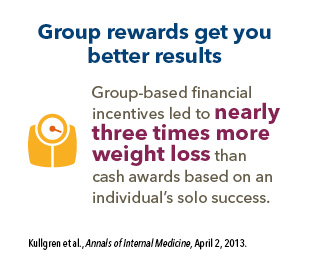Leading by Example in Workforce Health
How Kaiser Permanente walks the walk by rewarding healthy behavior
Feb 14, 2014

Giving employees an incentive to make healthy changes isn’t a new concept, but it’s one that’s quickly gaining in popularity. More than two-thirds of employers offer financial incentives, and studies have shown they’re an effective way to boost employee participation and engagement in workforce health programs.*
But most incentives focus on rewarding individuals for making changes. The workplace inherently presents a group dynamic — offering employers the opportunity to build a culture of health that supports community rewards. A strong peer support system enables employees to make significant and lasting changes that can reduce your overall costs while boosting morale and performance. That’s why on January 1, 2014, we introduced our Total Health Incentive Plan — a new group-based program for Kaiser Permanente employees that takes us another step forward on our journey to improve employee health while continuing to set an example for our customers and fellow providers.

Rewarding our employees for good health
Developed as part of the collective bargaining agreement between Kaiser Permanente and the Coalition of Kaiser Permanente Unions in 2012, the Total Health Incentive Plan offers group-based rewards to encourage our employees to improve their health. Employees can earn incentives for completing an online Total Health Assessment, maintaining up-to-date biometric screenings, and improving on four key biometric risk measures — smoking, blood pressure, BMI, and cholesterol. Results are collected and then aggregated with other participants in the same geographic region.
Rewards are based on group health improvements rather than individual results. Over the course of a year, we’ll track the progress of participating employees by region. If a region hits its group health goals, all of its employees can earn cash rewards of up to $500. And the program is completely voluntary — no one is penalized for not participating or meeting goals.
One of the largest private electronic health record systems in the world securely connects more than 10 million members to their personal health information and their care providers.
Better results for your employees when caregivers are connected
When doctors, pharmacists, and specialists are connected to the same electronic health record (EHR) system, your employees can expect better health outcomes. Patient information is in one place, helping caregivers make better decisions. For example, a pharmacist looking for a patient’s medication allergies in the EHR database would be able to remind that same patient that it’s time to schedule a cancer screening.
In 2013, we co-sponsored the Forum for Healthy Behavior Change. Hear from some of the health care experts who spoke at the Forum in the video above.
Part of a larger mission with proven results
The Total Health Incentive Plan relies on our strong labor and management partnership to build a culture of health through teamwork and collective support. It’s just another step forward in our commitment to improving the health of our employees while maintaining a best place to work. Since our workforce wellness programs rolled out to all our regions in 2010:†
- BMI average for our employees has remained steady.
- Smoking and cholesterol statistics have improved.
- Blood pressure is at healthy levels for many of our employees.
In the last three years, we’ve released a wealth of innovative, motivational programs and tools to our employees — from healthy meeting resources to a healthy eating toolbox and healthy foods in our cafeterias and vending machines. We even removed deep-fat fryers and deep-fried food from our hospital cafeterias in Southern California. And our efforts are paying off. Some of our worksites hold Instant Recess®, and all of our campuses are smoke-free. And Local Union 30 — the Office and Professional Employees International Union — now only serves healthy food at their monthly steward meetings
To find the workforce health strategy that’s right for your business, please contact your Kaiser Permanente representative.
Also, check out our downloadable, no-cost resources and tools for building a culture of health at work.





